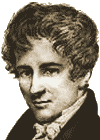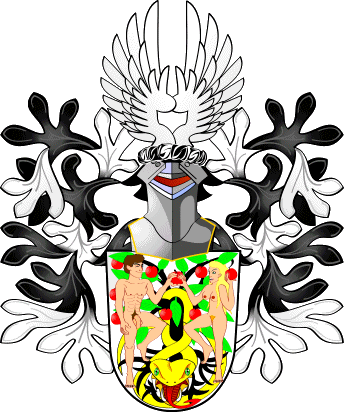In the above pictorial rendition, Jochen Wilke
chose to depart significantly
from the traditional conventions which would have prevailed in
a 19-th century representation of Abel's arms
(where Adam and Eve would have been shown breeched,
or with fig leaves).
Wilke himself just volunteered the comment that he did not feel
"bound by Christian symbolism" about this issue and/or the "protective"
posture of the snake.
Still, we can't resist the temptation (pun intended) to
point out that Wilke's picture is biblically correct
because we're told that Adam and Eve did not feel a need to cover their nakedness
before this very incident with the Serpent.
It's also anatomically
correct inasmuch as Adam and Eve don't have belly buttons
(think about it). 

The fact that "Abel" was the name of the second son
of Adam and Eve may have played a rôle in the design of these arms,
which Niels Abel inherited from his Danish ancestors.
According to Hans Cappelen's "Norwegian Family Arms" (the source quoted
by Jochen Wilke) the above arms were already used in the 1690's.
Another version of the same arms would show Adam and Eve
supporting an inescutcheon charged with the tree and the Serpent.
This would properly place the focus on the parents of the biblical
Abel, with the mythical tree & snake serving merely to identify the couple...
By itself, however, this particular tree is an overloaded symbol:
The Tree of Knowledge :
The open book featured in the coat-of-arms of so many universities remains the most
common symbol for academic knowledge in Western heraldry.
However, the trivial misunderstanding described below is increasingly making
the fruit-bearing biblical Tree of Knowledge serve
in this heraldic capacity as well.
Although there's little or no biblical indication concerning the botanical nature of
the forbidden fruit,
the traditional imagery uses (red) apples, possibly because of a medieval joke
involving the similarity between the Latin words for "apple"
(malum) and "evil" (malus).
In heraldry, the Tree of Knowledge itself
may appear either implicitly (as in the
arms of Gauss) or with explicit
biblical references
(Adam and Eve, the tempting Serpent, or both).
One typical example of the "modern" meaning(s) assigned to the symbol can be found in
the motivation provided by Geoffrey Masefield
to support his early informal proposal (dated 14 September 1966)
for the coat-of-arms of
Wolfson College, Oxford.
Oher examples of actual academic arms or logos featuring the
Tree of Knowledge tend to be of fairly recent origin. They include
Bristol UWE,
Tilburg University
(2002),
etc.
However, in explicit cases at least, the biblical symbol is clearly misunderstood
either by would-be heralds or by biblical scholars (if not both).
This biblical tree, not to be confused with the equally biblical
Tree of Life,
is better called the "Tree of Knowledge of Good and Evil",
the "Tree of Knowledge of Right and Wrong" or the
"Tree of Conscience"
(conscience being opposed to the simpler awareness
of animals).
The "knowledge of Good and Evil" corresponds to the
loss of innocence, after which evil things can be done
knowing that they aren't good.
Arguably, this is a precondition for free will,
righteousness
and souls worth fighting over,
but it's also what makes sin possible.
Christian doctrine thus connects the
forbidden fruit (eaten in defiance of God)
to the original sin and the need for salvation...
We're very far from mere academic or scientific
knowledge, aren't we?
The Abel Prize :
The Niels Henrik Abel Memorial Fund
was established on 1 January 2002, to award a yearly prize for outstanding work in mathematics.
The prize comes with a substantial monetary award similar to Nobel prizes
(there's no Nobel prize in mathematics) namely
6 million NOK (about 750,000 Euros or $1,000,000). the first recipients of
the Abel Prize have been:
Niels Abel himself
produced many brilliant results during a short life spent in poverty:
Non-solvability of quintic equations by radicals,
double periodicity of the elliptic functions, etc.
An offer for his first professorship
(at Berlin)
arrived two days after he had succombed to tuberculosis.




